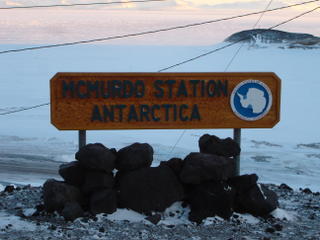
The official sign with Hut point in the background.
Vince's cross is barely visible on the point.

Building 155, right across from the hospital. The Galley (cafeteria), store, HR, Finance and other support offices are in this building. The food is good and unlimited so you have to watch your weight!

McMurdo General Hospital. During the winter there was a physician, P.A., and a physical therapist. Right now we have myself, two physicians, a P.A., a nurse, and a lab technician. When main body deployment arrives in October we will add another nurse and a physical therapist.

This is my dorm - #209. This is one of the "upper case" dorms which are pretty nice.

This is my room, my bed is in the background. Almost everyone here has a roommate. I lucked out and I have a good roommate that manages the heavy machinery repair shop.

Recycling is huge here! It is very expensive to ship anything here and equally expensive to ship all the waste out of Antarctica. This whole continent is ruled by the pack it in - pack it out philosophy. Everyone here tries to minimize the impact on the Antarctic environment. Every building has recycle bins such as these where you sort all of your trash. These bins are in my dorm.

A view of the water and power plants. All of the utilities between buildings are above ground. This allows access because the ground is always frozen. Power lines are all over town and the utility pipes which carry water, waste water, and fuel go across town with small bridges over them that allow people to walk over them. In some places they go under the roads for a short distance.

One of the Docs inside of the front door to the Crary Lab, the main research facility at McMurdo. When he opened the door a cloud of -22 degree air swept over us just like you were walking into a freezer.

A better view of a Ford truck with Mat Tracks instead of wheels.

The helicopter pad at the edge of town. In the summer they are used extensively to supply field camps set up to conduct research in places like the dry valley area of Antarctica.

A view of Hut point with Vince's cross and the Society Range of mountains across McMurdo sound.

We sometimes walk out to Scott's hut after work to view the long sunset. Everyone works from 7:30am to 5:30pm six days a week - 54 hours.

The end of another great day at the bottom of the Earth!
Best wishes to family and friends!
Bob




















































